In a year when the country is celebrating Azadi Ka Amrit Mahotsav, nuggets from independent India’s history, tucked across the country with individual collectors, are coming to the fore.
One of the rare collectibles with a Bengaluru-based numismatist are currency notes containing the portrait of King George VI printed in post-independence India. These were printed between August 15, 1947, and January 26, 1950, when India was a dominion in the British Commonwealth.

Despite India attaining independence, it continued to print currency notes of the denomination ₹1, ₹2, ₹5, ₹10, ₹100, and ₹1,000 from the security press at Nashik that had the portrait of King George VI to maintain continuity.
“India continued to print the same notes with little changes till it became a republic on January 26, 1950. Not many notes were published though. The pre-independence design was continued but to mark the country’s status, the colour of the serial number was changed to red and green,” says Rajendra Maru, who has these notes in his collection.
“For example, India continued the same ₹1 but with the serial numbers printed in red. Before independence, the serial number in ₹1 currency notes were in black and green. The colour of the serial number signified the period of printing,” said Mr. Maru. In his collection is a ₹1 note printed sometime in the last week of August or the first week of September in 1947.

Money in circulation
While printing of currency with the portrait of King George VI was discontinued after India became a republic, they continued to be in circulation till October 27, 1957, before they were withdrawn.
When India gained independence on August 15, 1947, an estimated ₹1,181 crore in currency notes was in circulation in the undivided India. The last set of currency notes with the portrait of King George VI was printed on January 20, 1950.
Slowly, these notes were replaced with those that contained the country’s national emblem – the Lion capital of Ashoka from Saranath as rendered by Dinanath Bhargava after India became a republic.
However, India also released two notes of ₹10 with the Ashoka Lion and signed by the first RBI Governor C.D. Deshmukh on December 1, 1949, and a ₹1 note with the Ashoka Lion on August 12, 1949, before the country became a republic.
According to Mr. Maru, the notes printed when India had a dominion status were in great demand in the collectors’ market with many of them now fetching several lakhs.
Azad Hind coin
A rare cupronickel coin released on August 15, 1947, by the Azad Hind Fauj is a collectors’ delight. It was minted in Kolkota to commemorate the independence of India from the British, and contains a flag and a pre-partition map of India.
“Though it is not a legal tender nor has any denomination, it is classified as ‘very very rare’ in the numismatic circle,” says Rajendra Maru, who has the coin in his collection.







